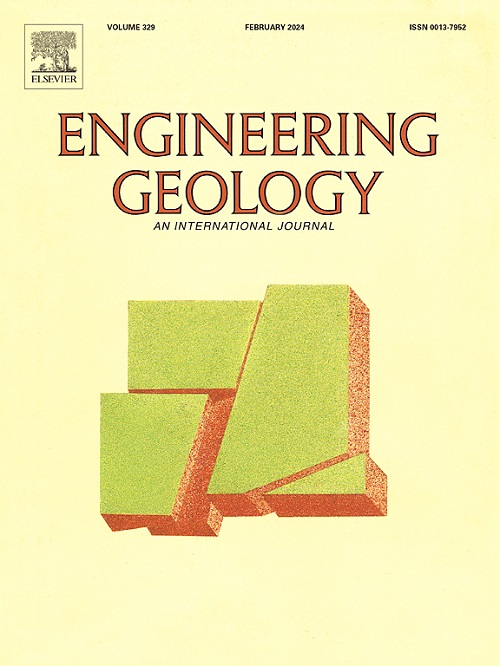Deformation and failure evolution mechanism of valley slope induced by dominant crack propagation: Insights from transparent soil modelling
IF 6.9
1区 工程技术
Q1 ENGINEERING, GEOLOGICAL
引用次数: 0
Abstract
Rock slope failures occur frequently in mountainous regions. However, research on the internal deformation and failure evolution mechanism of fractured valley rock slopes caused by dominant crack propagation remains limited. To address this knowledge gap, this study used the bank slope of the newly constructed Nujiang Grand Bridge as a prototype to perform model tests on slopes with dominant cracks at the slope top (M1 model) and slope toe (M2 model) utilizing a self-developed visualized model experiment system. Experimental data from the top load and displacement cells, along with the Particle Image Velocimetry (PIV) technique, were utilized to analyze the load-displacement response curves, displacement, velocity, strain rate fields, and propagation characteristics of the dominant crack in the slope. The results indicated that: (1) the load-displacement curves for both M1 and M2 models could be divided into four stages: slow acceleration, approximately uniform increase, slow deceleration, and rapid decline. The ultimate bearing capacity of the M2 model was about 3.2 kN larger than that of the M1 model. (2) The deformation and failure process of the slopes in both models could be categorized into three stages: initial deformation, rapid deformation, and failure. The M1 and M2 models exhibited “thrust-type” and “retrogressive” landslide failure characteristics, respectively. (3) The length of the dominant crack propagation segment increased exponentially with increasing loading duration, and the slope deformation showed obvious zonal characteristics. (4) The comparison of deformation and failure characteristics between the model and prototype slopes validated the rationality and accuracy of the model test. This study offers valuable insights into the internal deformation and failure evolution mechanism of fractured valley slopes resulting from dominant crack propagation.
显性裂纹扩展引起的山谷边坡变形破坏演化机制:来自透明土模型的启示
岩质边坡破坏是山区常见的破坏现象。然而,对裂隙型山谷岩质边坡由优势裂纹扩展引起的内部变形和破坏演化机制的研究仍然有限。为了解决这一知识空白,本研究以新建怒江大桥岸坡为原型,利用自行开发的可视化模型试验系统,对坡顶优势裂缝(M1模型)和坡脚优势裂缝(M2模型)边坡进行了模型试验。利用顶部荷载和位移单元的实验数据,结合粒子图像测速(PIV)技术,分析了边坡主裂纹的荷载-位移响应曲线、位移、速度、应变率场和扩展特征。结果表明:(1)M1和M2模型的荷载-位移曲线均可划分为缓慢加速、近似均匀增加、缓慢减速和快速下降4个阶段。M2模型的极限承载力比M1模型的极限承载力大3.2 kN左右。(2)两种模型下边坡的变形破坏过程可分为初始变形、快速变形和破坏三个阶段。M1型和M2型滑坡分别表现为“逆冲型”和“倒退型”滑坡破坏特征。(3)随着加载时间的增加,优势裂纹扩展段长度呈指数增长,边坡变形呈现明显的带状特征。(4)模型与原型边坡的变形破坏特征对比验证了模型试验的合理性和准确性。该研究对裂隙型山谷边坡在主导裂纹扩展作用下的内部变形和破坏演化机制提供了有价值的认识。
本文章由计算机程序翻译,如有差异,请以英文原文为准。
求助全文
约1分钟内获得全文
求助全文
来源期刊

Engineering Geology
地学-地球科学综合
CiteScore
13.70
自引率
12.20%
发文量
327
审稿时长
5.6 months
期刊介绍:
Engineering Geology, an international interdisciplinary journal, serves as a bridge between earth sciences and engineering, focusing on geological and geotechnical engineering. It welcomes studies with relevance to engineering, environmental concerns, and safety, catering to engineering geologists with backgrounds in geology or civil/mining engineering. Topics include applied geomorphology, structural geology, geophysics, geochemistry, environmental geology, hydrogeology, land use planning, natural hazards, remote sensing, soil and rock mechanics, and applied geotechnical engineering. The journal provides a platform for research at the intersection of geology and engineering disciplines.
 求助内容:
求助内容: 应助结果提醒方式:
应助结果提醒方式:


